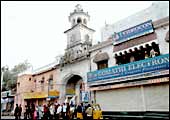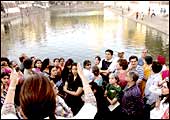|
BANGALORE
Victoria Redux
Sunday
morning. 7.30 a.m. and I am standing over the grave of a soldier
who died in 1806. Actually, there is no grave; my memory is a
bit dodgy on the date too; but there is a dead soldier, at least
a plaque dedicated to him. There are several plaques in the church-did
it slip my mind to mention that I am in one, Trinity Church-and
each is dedicated to a soldier; many, I am told died on the long
voyage from England to India. This, Trinity Church, was the preferred
place of worship of the resident English upper class in the 1700s,
1800s and part of the 1900s, right up to India's independence.
It was also used to measure Bangalore's elevation (height above
sea level, and anyone who has even a casual acquaintance with
trigonometry can show you how this is done) at one time, a small
engraving on the second step leading up to the church attesting
this fact.
There are six of us here on this overcast
morning. We are here to take a walk through time. It is a two-km
walk, which will take around two hours to complete and Arun Pai,
Big Five consultant at one time, venture capitalist, Bangalore-boy
(he claims to have played street cricket with another Bangalore-boy
Rahul Dravid) and walks-entreprenuer (he has several, including
a pub crawl), is our guide. This is the Victorian Bangalore walk
and it starts at around the time Major (later Lord) Cornwallis
defeated Tipu Sultan in the Battle of Mysore (1792; the Third
Mysore War) and ends at the turn of the 20th century, when the
Empire was at its peak.
The walk takes us-an assorted bunch of long-time
residents, recent migrants and tourists-through famous streets,
villas and churches. "I am not a qualified tour guide or
a historian," admits Pai. "Bangalore just has some interesting
history and walking seems to be the best way to tell it."
He has spent time with old-timers, read cartloads of books and
is a veritable fount of interesting (and sometimes gristly) trivia.
Human sacrifices at Trinity Church, anyone? We visit several villas
that have survived the ravages of time and the demands of a growing
city; one such is the residence of V.S. Thiruvenkataswamy, a man
who made his fortune by cornering contracts for supply of oil
to the British. We also walk through Mayo Hall, which today hosts
several courts. It was originally built to honour the memory of
Lord Mayo, the only Governor General of India killed in office.
Then we are back on the arterial mg Road, walking past the remnants
of Tom's Pool Parlour, another Bangalore landmark of times past.
"The Bangalore I know is all it, but there's so much history,"
gushes fellow walker Radhika Lakshman, a British Indian yoga exponent.
That there is.
Contact: www.bangalorewalks.com
-Rahul Sachitanand
 |
| Chandni Chowk: Born in 1650 as Shahjahanabad,
this part of Old Delhi still thrives |
DELHI
Walkin' Blues
In one of those
ironies that make a reporter's day, I discover, in my quest for
a good walking tour that Delhi, the city with the most cars in
the country also has several walks. intach (Indian National Trust
of Art and Cultural Heritage) has two, one of Old Delhi and another,
Mehrauli; and The Habitat World (at the India Habitat Centre)
has Habitat Walks on most Sundays.
I pick the Old Delhi walk and find myself
standing in front of a Jain temple opposite Red Fort on a still-nippy
Saturday morning. There are 10 others with me, including Bhanupriya
Rao, intach-volunteer and history buff. It was in 1650 that Mughal
emperor Shah Jahan started building what is now known as Chandni
Chowk. He named the place Shahjahanabad.
Chandni Chowk was divided into lanes, with
each lane housing people of a particular vocation; lanes such
as Kinari Bazaar, Chawri Bazaar and the famed Paranthewali Gali
exist even today. The area is full of surprises: the local branch
of State Bank of India is in an 18th century colonial house that
was once part of the estate of a famous courtesan Begum Samroo;
further down is Sunheri Masjid, from the minarets of which Nadir
Shah supervised his army's sacking of Delhi in 1739.
We walk past Paranthewali Gali where the
wok-like utensils used to fry bread are slowly coming to life,
and Sheesh Mahal, a decrepit building that once housed St Stephen's
College. Stopping only to sample some Makhan Malai, a frothy concoction
of whipped cream, yellow gobs of butter and coarse ground sugar,
we walk down the brass-makers' lane, Gali Guliyan to the Jama
Masjid. That very imposing structure (circa: 1650s) is a fitting
end to the walk.
More information at: http://www.intach.org/pdf/DelhiHeritageWalk.pdf
-Amanpreet Singh
HYDERABAD
Eight For The City
 |
| Shah Ali Banda: A busy street in the
old city of Hyderabad |
Get this: Hyderabad
has not one or two walks, but eight. They are organised, in turn,
on the last Sunday of every month by the local tourism department.
This Sunday, it is the turn of the Shah Ali Banda Walk. The walk
starts from Rafa-e-Am, one of the oldest schools in the city (founded
in 1895), and about 12 km south of Hyderabad's central business
district, Somajiguda. Over the next two hours we pass: houses
of minor retainers of the Nizam; the Jali Ki Masjid, thus named
after the intricate jali (lattice) work that characterises it;
an old Hanuman temple; the city walls themselves (built by the
Mughals who occupied Hyderabad in 1680); and Aliabad Sarai which
once served as a checkpoint for visitors. The walk ends there,
outside one-room structures along the walls that once housed horses.
Today, they do shops.
For More information: www.aptourism.com
E. Kumar Sharma
 |
| The French connection: Joraghat at the
Strand in Chandannagore |
KOLKATA
Rue de l'histoire
Kolkata's best-known
walk isn't actually in Kolkata; it is in Chandannagore, an old
French settlement 39-km from the city. The walk from one end of
the promenade at the settlement to another, a distance of 1.5
km, takes around 30-minutes. Called the Chandannagore Heritage
Walk, it is organised by Chandannagar Heritage, a non-governmental
organisation (NGO), and is a veritable walk through the area's
history. Chandannagore first became a French colony in the late
1600s; its ownership changed several times till 1815 (this was
a period when Anglo-French rivalry was at its peak) when it reverted
to the French who ruled over it till 1952 when, along with Pondicherry,
it became part of India.
The promenade, or Strand, as locals term
it, is bedecked with lights and surrounded by lush foliage. Every
second building has a history to it. Then, there's Institut de
Chandernagore, one of the oldest museums in this part of the world.
Among its exhibits is a canon used in the Anglo-French wars. Further
down the promenade is a church that is over 200 years old; a temple
of similar vintage that now serves as an auditorium and library;
and finally, near the river (the Ganga), a dilapidated structure
with its lower floor fully submerged. This is Patal Bari (the
underground house), and it is where Rabindranath Tagore and reformer
Ishwar Chandra Vidyasagar used to stay on their visits to the
settlement.
For more information: www.geocities.com/www.chandannagore.cutecity.com
-Ritwik Mukherjee
MUMBAI
Secret River
 |
| Banganga: Mumbai's oldest Hindu holy-spot
actually happens to be in Malabar Hills |
If Hindu mythology
is to be believed, we are standing on the banks of a water body
created by Lord Ram. This is the Banganga tank in the Malabar
Hills borough of Mumbai, and the source of the water is supposed
to be an underground tributary of the Ganga that came to the surface
as a spring when Ram, on his way back from 14 years spent in exile,
and thirsty to boot, shot an arrow into the ground to tap a vein
of water. "Banganga was the first of all Hindu sacred places
in the city," says Abha Bahl, an architect who works on projects
that have something to do with urban design and heritage conservation,
and co-founder of The Bombay Heritage Walks (it organises, apart
from the Banganga Walk, 19 others, with 14 around the Fort area
and four in different areas of the city).
On this Sunday, there are around 50 of us
standing by the side of the 150 m X 170 m tank. In the exact geometric
centre of the tank is a long metal rod, symbolising Mount Meru,
the centre of the world according to Hindus. All around the tank
are temples. Our walk takes us to seven of them (and two memorials).
The most famous of these is the Walkeshwar Mandir; the original
was reportedly destroyed by the Portugese; what stands in Banganga
today is a 20th-century reproduction. Most of the temples have
undergone renovation; the only one that hasn't is the Jabreshwar
Mahadeo temple, built in the 1800s (the temple looks as if it
was forcefully placed where it is, on top of a flight of steps,
by a giant hand; that explains its name; Jabreshwar is derived
from the Hindustani word for force, zabardasti).
Along the sides of most temples are the residences
of priests. Some fifth generation priests live in a few houses;
in others, there are people who have nothing to do with the temples.
And right in the middle of this (the tank, the temples, the priestly
residences) are some modern residences. Then, this is Mumbai.
For More information: e-mail: heritagewalks@hotmail.com
-Ahona Ghosh
|








